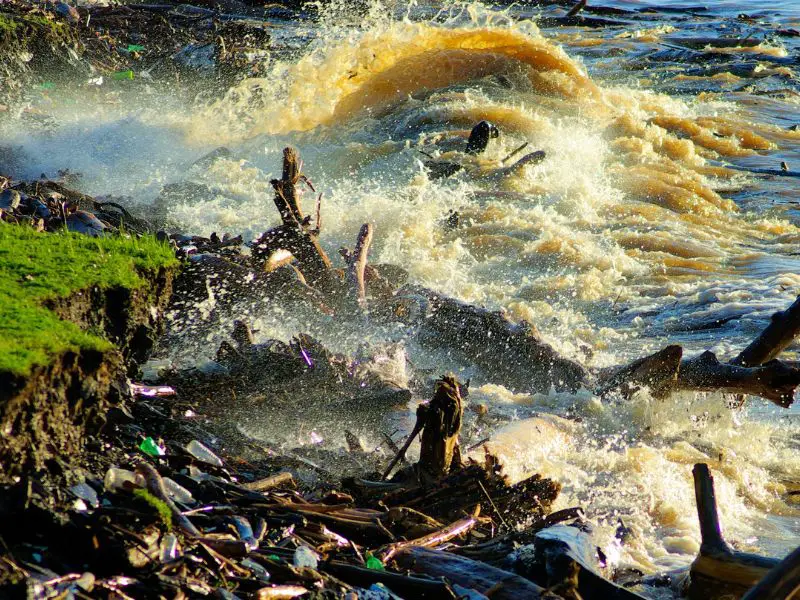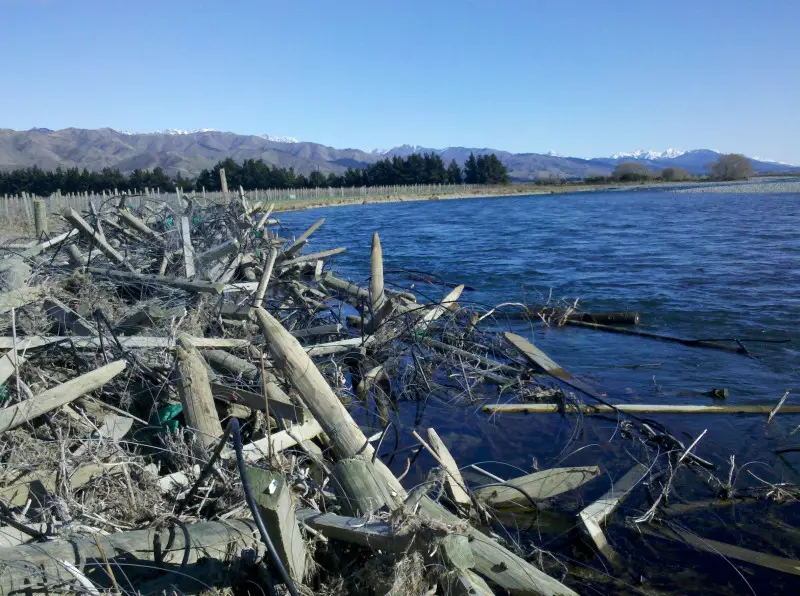When it comes to trout fishing, and trout habitat too much water can almost be as bad as too little.
How trout respond to a flood largely depends on the size of the flood, and the trout’s ability to get out of the main current. A large flood roaring down a steep-sided canyon is a lot more devastating to the aquatic life than a similar size flood that disperses across a wide flood plain.
It is also apparent that the steeper the gradient, the harder the conditions become for the trout. Finally, trout tend to fair worse in rivers that contain a lot of lost substrate compared with ones with significant amounts of exposed bedrock which can provide shelter for trout in all but the worst of floods.
Extreme flood events that occur close to or around spawning can also devastate entire year groups of fish.
The Impact of levees and flood control infrastructure
Man-made levees and flood control embankments have a similar effect as the walls of a canyon, they prevent the flood water from spreading sidewise, forcing it down to a predefined channel.
This channeling effect can be somewhat limited where there is riparian strips or floodway between the normal river channel and the levees. In saying that, the entire purpose of levees is to control and channel floodwater and force the entire volume down a confined channel. This does limit a trout’s ability to escape the main force of a current during a major flood event.

So what do trout do during floods?
When flow rates are still manageable, trout typically try to ride out floods or use it as a chance to migrate. Trout can be very mobile during floods, some traveling many miles both with and against the current. While most trout move downstream during periods of flood, some do indeed travel further upstream.
Sometimes trout will stay in their feeding lies intercepting the bonanza of dislodged food. Due to the lack of water clarity, they can be a bit hard to catch but larger streamers or slow floating artificial worms often bring results.
During extreme flood events, trout will quickly start to spend more energy fighting against the current than they gain from feeding. In such events, trout try to get out of the current. They can do that in a number of ways.
- – Laying close to the bottom.
- – Sheltering behind boulders, or against undercut banks.
- – Seeking shelter in calm backwaters.
- – Travelling to deeper, slower portions of the river.
- – By moving into the extreme shallows.
- – Travelling up smaller tributaries that contain less flow
Another, New Zealand based study recorded trout numbers by drift diving 7 South Island rivers both before and after a major flood event. The results of this study shows how after major floods trout populations are likley to migrate from areas of steeper gradient to slower moving parts of the river.
Brown trout numbers declined on average 82% in 6 of the 7 rivers following a major flood event.
- Small fish declined between 30% to 100%,
- Medium-sized fish varied from 62% to 87%.
- Large brown trout were present in sufficient numbers in two rivers, where they declined by 26% and 57%.
Trout abundance in the final river increased threefold. This increase in trout numbers was likely due to the abundance of ‘refuge’ habitats in that portion of the river. It also had a lot lower gradient which would have resulted in slower water velocity during the event.
Rainbow trout were present in three of the rivers prior to the flood, but persisted in only one after the flood.
The number of small rainbow trout in this river dropped by 94%, medium-sized fish remained scarce, and large fish, which were absent prior to the flood, increased to 14 after the flood. The increase in mature rainbow trout numbers was put down to migration, the researchers did not know in what direction.
What do rainbow trout do in floods?
I have been told that rainbow trout are stubborn and they will try to fight the current, and when it becomes too powerful they will allow it to carry them many miles downstream to rest out the flood in areas of low flow. This is one of the reasons why rainbows do so well in river systems that contain lakes.
I do know, that rainbow trout can be displaced by large flood events. Often turning up where I will not expect to find them.
I know of one flood prone river in New Zealand, it is a bit like a funnel, the headwaters are steep and narrow and it opens up and slows as it approaches the sea. While not overly long (the entire catchment is only some 40km / 25 miles), the catchment is prone to violent floods that can rip through the valley at quite some pace.
After such floods, it is not uncommon to catch rainbow trout several miles out to sea. There are no steelhead or sea run rainbow trout in New Zealand, so I can only speculate that they followed the flood water out into the sea to escape the current.
What do Brown trout do in floods?
It is widely considered that brown trout try to get out of the current and into a refuge much quicker than rainbows. They can do so in the following way.
– Try and find shelter by resting behind or beneath structures such as large boulders. This works fine in smaller flood events, but extreme events can dislodge all but the most secure of structures which can result in crash injuries for the trout. On drift dives, brown trout are often seen with injuries after extreme floods, and the cause is largely put down to impact from debris.
– Towards the margins and backwaters. Brown trout have a reputation of feeding in the extreme shallows during floods. Shallow water on the edge of the flood generally has a much slower flow than the main current, it can also be rich in drowned insect life. Providing an easy meal for the trout.
– Finding refuge in spring eruption zones, I have seen brown trout try to avoid the dirtiest of floodwater by sitting inside the clear water of spring eruption zones as brown chocolate milk swirls around them. I also speculate that the current of the erupting spring will likely cause turbulence resulting in a pocket of slower flow allowing the trout to rest. In saying that, as the volume of the flood increases such spring refuges will likely be overwhelmed.

What percentage of trout survive a flood?
I personally believe, that most mature trout survive most flood events, although they might have used the higher water levels as an opportunity to move. So it could take some effort to find where they are holding.
Extreme floods can be a different story.
A radiotelemetry study tracked the movement of adult brown trout in the Motupiko River, New Zealand. During the study a 50 year flood event hit, resulting in a mortality of 60-70% of the tracked fish. (source)
My own experience of a major flood in a trophy trout stream
I grew up near a trophy trout water, a stunning valley with usually stable flows. On a good day, it will be possible to spot over 50 trout while walking the valley. Many exceed 5lb in weight. In I think the spring of 2012 the catchment was hit by an absolute river bomb. It must have been a sight to see, and several hikers had to be evacuated by helicopter.
I had to wait several weeks for the access road to be repaired to check on my valley. The impact on the river was obvious. New channels were formed, deep pools I have been fishing for years were filled in and new ones were dug out. Overall, there was a net loss of ponds.
Entire meadows of riverside herbs were ripped bare revealing beaches of silk, sand, and gravel. Countless skeletons of mature trees littered the river bed. It was like the entire canvas of the valley was wiped cleared and the river reformed itself.
So before the flood, I was sighting about 50 trout per trip, after the flood, I counted 3. It was total annihilation. Even though the aquatic insect life was gone, it was challenging to find a single mayfly nymph.
With that said, the damage was surprisingly short lived, and by the end of summer the valley was fishing decently again, but it took until next spring for large numbers of fish to return. I suspect the trout which survived, must have migrated downstream in search of food. Because the valley was left barren.
Where do stock trout go during floods?
One study (source) in a small Austrian stream compared the movement of stock and wild brown trout after a flood event. After the flood, 89% of the stocked trout were recaptured within the 3.5km area which was monitored. Compared with only 15% of the wild fish.
This data suggested that the wild trout migrated significantly further during the period of the study What is less certain is whether the movement difference was due to the flood or the difference in behavior between the stock and wild fish..
Juvenile trout can have a very rough time
Extreme flood events can all but wipe out entire year groups of juvenile trout and the timing of the flood events can be just as typical as the severity.
A study (source) looked at the effect of flood on stream dwelling Brook trout in Monongahela National Forest, West Virginia. During the spawn, the redds were scoured by a significant flood event that was powerful enough to reform pools. This resulted in a 98% reduction in newly born trout and an 84% decline in the number of yearling trout.
Other researchers have found that it can take up to 6 years for population densities to return to normal after a severe flood event.

